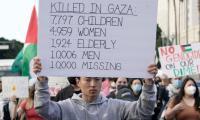LAHORE: Originally scheduled to be held on August 18, 2020, but postponed in July this year due to coronavirus, the third 2020 Gilgit-Baltistan (G-B) Legislative Assembly elections will now take place in 24 constituencies of this extremely picturesque part of the planet on November 15.
Not fewer than 330 candidates will contest this ballot exercise for the 33-member Gilgit-Baltistan Assembly and would either be representing one of the 14 officially registered and recognised political parties of Gilgit-Baltistan, or would be pitching themselves an independent candidates.
Basically, more than 700,000 voters will exercise their right of franchise elect 24 candidates in general elections of this scenic region, where leaders of all top national political parties are currently busy delivering fiery speeches against each other and making pledges and promises ahead of the polls.
Gilgit-Baltistan's demography and sectarian profile:
According to the "Gilgit-Baltistan Scouts," this scenic area is a meeting point of world's three famous high altitude mountain ranges, namely Himalayas, Karakoram and Hindu Kush, which border Pakistan's Khyber Pakhtunkhwa province to the West, Afghanistan's Wakhan Corridor to the North, China to the Northeast, Azad Kashmir to the Southwest, and Indian Occupied Jammu and Kashmir to the East and Southeast.
The "Gilgit-Baltistan Scouts," which are part of the Pakistani paramilitary forces operating under the direct control of the Federal Interior Ministry, Gilgit-Baltistan covers an area of 72,971 square kilometers and has an estimated population of 1.249 million.
The scouts, which are an internal security force with the prime objective to protect northern borders of Pakistan and support Civil Administration in ensuring maintenance of law and order anywhere in Pakistan, maintain on their website: "Its administrative centre is the city of Gilgit with a population of 216,760. The area contains some of the largest glaciers out of polar regions, which are Biafo, Baltoro and Hisper. This region is a notable supplier to the country as well as the world of many important minerals. In the Southern part of the region, it has major deposits of nickle, cobalt, copper, lead, tin, bismit, mica, quartz, zircon, coal and actonolite that are famous for their exceptionally good quality. Silk Route is the major and only road link between this area and other parts of the country, utilised mainly for economic activities."
Recently named as Gilgit-Baltistan, this region was given full autonomy on August 29, 2009, rendering it constitutional status of an integrated part of Pakistan.
Gilgit-Baltistan comprises of two divisions, seven districts and 22 tehsils. Skardu and Ghanche are in Baltistan Division, while Diamer, Ghizar, Gilgit, Astore and Hunza Nagar are in Gilgit Division. The region in the opinion of geologists is the meeting ground of "Continents of Collision."
According to the "Gilgit-Baltistan Scouts," with a population of 0.196 million, Gilgit has 35 per cent Sunni, 45 per cent Shia population, 19.5 per cent Ismaelis (followers of Aga Khan) and 0.5 per cent Bakhshis.
With a population of 0.289 million, Skardu has only 6 per cent Sunnis, 88 per cent Shias, and 6 per cent Bakhshis.
Similarly, 0.177 million inhabitants of Diamir comprise 100 per cent Sunnis, while Ghizer has 85 per cent Ismaelis, 10 per cent Sunnis, and 5 per cent Shias breathing on its soil. Ghizer's population stands at 0.162 million.
Ghanche has 0.199 million people, 23 per cent of whom are Sunnis, just 2 per cent hail from the Shia sect and 75 per cent are Bakhshis.
Astore region has 0.096 million people, 70 per cent of whom are Sunnis, and 30 per cent are Shias.
Hunza-Nagar has a population of 0.130, constituting 55 per cent Shias and 45 per cent Ismaelis.
Overall, the Gilgit-Baltistan sectarian profile shows that 28 per cent Sunnis, 41 per cent Shias, 20 per cent Ismaelis and 11 per cents Bakhshis live in this region.
In her book "Kashmir in conflict: India, Pakistan and the unending war," noted British journalist, biographer, and historian, Victoria Schofield, writes that Gilgit did not favour the accession to India, as was outlined in a letter written to the prime minister of Jammu and Kashmir by the erstwhile Governor of Gilgit, Ghansara Singh.
Meanwhile, eminent historian on South Asia, Yaqoob Khan Bangash's article "Three Forgotten Accessions: Gilgit, Hunza and Nagar," appearing in the Journal of Imperial and Commonwealth History, and a widely-acclaimed Australian political scientist, politico-strategic analyst, academic researcher and author, Christopher Snedden's books "Kashmir: The unwritten history and the "Untold story of the people of Azad Kashmir," also explicitly mention the fact that the people of the Frontier Districts Province (modern-day Gilgit-Baltistan) had strongly expressed their desire to join Pakistan.
Yaqoob Khan Bangash had revealed that Governor of Gilgit, Ghansara Singh, wrote to the prime minister of Kashmir that in case the State acceded to the Indian Union, the Gilgit province would go to Pakistan, but no action was taken on it, and, in fact, Srinagar never replied to any of his messages.
Christopher Snedden had written: "Similarly, Muslims in Western Jammu Province, particularly in Poonch, many of whom had martial capabilities, and Muslims in the Frontier Districts Province strongly wanted J&K to join Pakistan."
Tribes: Yashkun and Sheen are the major tribes here. However, some Moghuls, Rajas, Pathans, Kashmiris and Kashgiris also reside in this region.
Languages spoken: Shina is the main language in Gilgit. It is spoken in the Gilgit, Diamer, Ghizer and Astore. Shina speaking people are further found north in the Ishkoman valley and in Hunza, Nagar and further east in Baltistan.
Burushaski is the main language of Hunza valley. It is spoken by the people settled on either sides of the middle cause of the Hunza River, on its northern bank (Hunza) as well as on its southern bank (Nagar). There are also Hunza speaking settlements in Yasin and in Gilgit. Burushasky is still an unwritten language.
Khowar is the main language of Chitral, however Khowar speakers may be found in Yasin. Marriage ties make Khowar understood in Gilgit in some families.
Balti is the sector largest language in the Baltistan Division. It is mainly spoken in the two districts of Baltistan division. Balti peaking people are settled in Skardu, Rondu, Shigar, Khapolu, Kharmang, Gultari and Ganche.
Domaaki is the language of the Domas of Berichos who are also found in Gilgit and in the some Shina speaking villages of the lower Hunza valley. They are mainly musicians and smiths.
Wakhi is spoken in areas like Upper Hunza Valley by more than 3,000 people.
And Gojri is the language of Gojar family settled in Naltar valley chiefly.
Revisiting the 2015 polling exercise results in Gilgit-Baltistan:
The Pakistan Muslim League-Nawaz (PML-N) had swept the previous polls held five years ago when it was also in power at the federal level. Of the 24 directly contested seats, the PML-N had bagged 15, while its final tally had climbed to 21 seats with the addition of six indirectly elected special seats for women and technocrats/professionals in the previous elections.
The PPP had won two seats and the Pakistan Tehreek-e-Insaf had returned successful on just one seat.
The Islami Tehreek Pakistan had won three seats and the Majlis Wahdat-e-Muslimeen had secured two seats. The Jamiat-e-Ulema-e- Islam-Fazlur Rehman and Balawaristan National Front had secured one seat each. An independent candidate had also emerged triumphant in the 2015 elections.
Online E-Kachehri in progress on issues relating to property matters in sectoral areas of Islamabad. —...
The National Press Club building in Islamabad. — Facebook/group/npcnews/Islamabad: In a significant address at the...
The Sustainable Social Development Organisation and All Neighbors USA organised the International Religious Freedom...
Provincial Transport Minister Bilal Akbar Khan seen in this image on March 11, 2024. — Facebook/Bilal Akbar Khan...
The image released on Oct 20, 2023 shows Dr Moonis Ahmar giving a lecture. — Facebook/moonis.ahmarIslamabad: Dr...
India Study Centre at the Institute of Strategic Studies Islamabad organized an in-house session on the on-going...







